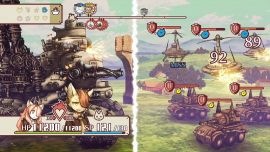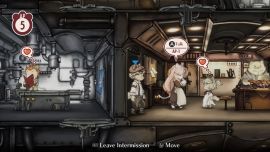Fuga: Melodies of Steel
Fuga: Melodies of Steel (戦場のフーガ, lit. "Fugue on the Battlefield") is the latest installment to the Little Tail Bronx series. This game is in the perspective of 12 Children who commandeer the Taranis, a large tank, as they take on the Berman Empire.
A sequel to the game, aptly titled Fuga: Melodies of Steel 2, is in the works and is set for a 2023 release. This part of Little Tail Bronx is planned to be a full trilogy.
Gameplay
Unlike the other two entries in the Little Tail Bronx series, where the player controls a Robo that can walk around a 3D space & toss enemies, the player instead takes control of a squad in side-scrolling, turn-based combat with prominent JRPG elements.
Battles

During battles the player must ward off a number of enemies who come in waves. To do so, each available child takes turns attacking with various abilities. Children can be paired together in three available turrets, each featuring two seats. The key to battle is to both stagger the enemy and lower their defenses, all of which can be seen by both the color-coded clock icons and numbered shields next to their life bars. Using the correctly colored weapons on the tank, which are assigned to specific children, and utilizing special attacks that lower defenses, can make battles a smooth victory.
Attacks & Abilities
The children of the Taranis come with an arsenal of normal attacks, special moves, and multiple types of status ailments. Each child is assigned one of three main weapon types; machine guns, grenade launchers, and cannons. Machine guns excel in speed & accuracy at the cost of effective normal damage, cannons deal heavy amounts of damage while having lower accuracy, and grenade launchers fall in-between while also featuring more status inflictors.
Special moves can be performed as long as the player has enough SP. While many of these moves are focused on inflicting damage, there are also healing abilities and status ailments. Some special attacks can inflict extreme damage upon the enemy at the cost of inflicting fear upon the children, so these moves must be used wisely. As the player progresses through Gasco they can obtain items that can perform the same effects as lower-end moves, making for cost-effective alternatives.
Affinity is key to unlocking the children's unique passive effects amongst each other, all of which can be unlocked at Affinity Lv. 2 and further improved upon up to Lv. 10. Affinity can be slowly raised between two children through battle if they're paired in turrets, though the most effective way to raise this is through conversations during Intermissions and eating food that boosts it. To activate a pair's Affinity ability, the player must seat either of the two into the backseat of a turret for their desired effect. Children with no Affinity between each other will not grant any passive effects.
Link Attacks are powerful moves that can be charged between a pair of children during battles. Once one is charged, the attack can be performed at any time and will need to be recharged after a single use. Link Attacks can inflict damage to all enemies and sometimes also grant the team with special buffs. The Link gauge will increase slowly after each turn normally but can be sped up through eating the proper food in Intermissions and specific Link-related special moves.
Hero Mode is a status buff that can be granted to any child seated in the front line of any of the three turrets, and its effect is unique to each individual. The qualification for entering Hero Mode is dependent on a child's mood, which is indicated by the cat mood icon seen in the battle UI and the Intermission notebook. Moods can be boosted through performing tasks during Intermissions and feeding the team well. Once Hero Mode is active it will last for five turns. While Hero Mode can be reserved by seating a child out of the frontline, it cannot be carried over between Intermissions.

Intermissions
When the player isn't in battle, the game enters an Intermission where one can interact with teammates to increase affinities, go scrap fishing, farm food & materials, embark on expeditions, cook, etc.. Each Intermission features 20 AP which is expended in differing amounts depending on which activities the player chooses to do. Once all of the player's AP is depleted, they must move the Taranis forward and head back into battle. AP will fully replenish in the next Intermission.
The most important feature of Intermissions is the notebook, which contains all the tasks and chores the children on board want to perform as well as specific food they want to eat. Fulfilling requests will increase moods with doing laundry specifically being more Affinity-centric. Those who are injured will almost always request sleep and children who are suffering depression can be cured via pep-talk, which also increases Affinity tremendously.
A rare event that can occur during Intermissions is named "Secret Garden". There is no known way to manually activate the event and seems entirely reliant on RNG. When a child can trigger this event, the notebook will have their request as "..." and feature the Hero Mode's red cat mood icon (they can also be seen visibly sweating). The player can then take control of the child in this state and guide them up to the very top of the Taranis which will have a swan-styled potty training toilet, which upon interacting with it will play a vaguely shot clip of them more than likely urinating. There is absolutely no known benefit to this and every child's Secret Garden clip is saved in the main menu.
It was revealed in an interview that the Secret Garden event was a last minute addition after CC2's president had doodled a training toilet. It will be reintroduced in Fuga 2 where it's "powered up".[1]
Upgrading the Taranis
The Taranis is customizable in many ways. The player can upgrade the tank's weapons, health, and defense with parts found through progressing the game, scrap fishing, and explorations. As the player levels up the machine gun, grenade launcher and cannons, all these weapons will show cosmetic upgrades.
Rooms in the Taranis can also be upgraded such as the bunker, kitchen, and farm. While parts for these facets can be found throughout Gasco, they are most commonly found in Explorations and bartering.
Explorations
Explorations are special events that can be both found in set areas throughout Gasco and revisited through the Taranis's observation room at the cost of AP. These events put the player's three chosen children into a side-scrolling mini dungeon full of treasures, traps, and insects. Each dungeon type has three different difficulty levels with each becoming more puzzling. The goal is to grab all available treasure and unlock the large treasure chest without losing all three children.
Soul Cannon
Fuga is difficult to play by design, pitting the player against tough decision making. Losing in a battle will reset the player back to either during or right after the last Intermission. If the player does not want to regress back to the last save point while in a pinch during a major boss battle, they can choose to fire the Soul Cannon. Using this ability will cause an immense amount of damage against your enemy at the cost of a child's life. Sacrifice is the only way to utilize the Taranis's super weapon and use of it will slightly affect the game's ending.
DLC
Fuga features two main DLC-exclusive features - costumes and the Soul Cannon dummy.
The dummy is exclusive to the game's Deluxe Edition (including the separate package version). It can be used in place of a child to fire the Soul Cannon and is replenished for every boss battle. While initially being a bonus tool to more easily complete the game, it's been revealed through the manga that the dummy is actually of importance to the overall story.
Costumes are the most plentiful form of DLC and can be changed at any time from the settings menu. The first set is exclusive to the Deluxe Edition and features swim wear for the entire crew. On Jan. 20th, 2022, a Japanese school-themed set was released. The second one, an Edo-centric set was released in Mar. 24th, 2022. The last costume pack, which was themed around western fantasy, was released in May 26, 2022.
Development
The conceptualization of Fuga was nearly solidified in just about an hour during a meeting within CyberConnect2. It was immediately decided that the game should be made on a much lower scale than their typical work with Bandai Namco, with this new title featuring side-scrolling and an RPG system akin to classics such as Final Fantasy & Dragon Quest. The concept of children manning a large tank and being put into the mercy of the Soul Cannon was also concrete during this time. The setting taking place in the world of Little Tail Bronx was decided near the end of this meeting.
Fuga was first publicly announced in March 2019 as part of CC2's self-publishing initiative titled "Trilogy of Vengeance", being developed alongside Tokyo Ogre Gate & Cecile. All three games were conceived under the company's "NEXT PLAN" agenda, which aims to have CC2 develop self-published titles for the next decade. Fuga is the first of all three games to release, with it being the biggest priority within the company.
The game was originally slated for a late 2019 release before being pushed into early 2020. While the COVID-19 pandemic served as a factor to the game being pushed even further back into 2021, the true reason for these delays was due to constant revisions to the game and inexperience. A physical release was planned for Fuga back in 2019 as there was a significant demand for one from fans. This plan, however, had fallen flat as CC2 would later announce that the game would be a digital-only release.
According to CC2, Fuga, despite being set in the same world of Little Tail Bronx as Tail Concerto and Solatorobo, has no connection with the latter two. It is a completely new work that is independent and complete by itself, so newcomers can play it without knowing any of the lore from the previous games. Fuga still makes fairly frequent references to Solatorobo despite this claim.
Fuga's development time & cost amounted to a total of 3 years and ¥327M. Despite CC2's best efforts to get the game around via word-of-mouth, it has yet to even break half of the total budget, with only ¥120M being made after three months of the game's release.
